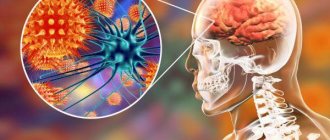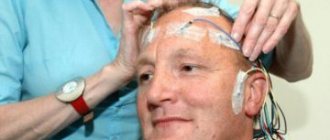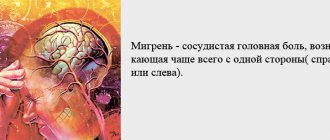What it is?
Hyperventilation syndrome (hereinafter referred to as HVS) is characterized by periodic episodes of disruption of the normal breathing rhythm, when after inhalation there is no subsequent exhalation, but inhalation occurs again.
This is accompanied by a feeling of acute lack of air, the appearance of a lump in the throat, and the inability to inhale a sufficient volume of air.
Despite the fact that there is no oxygen deficiency in the body, a deep breath is taken again. This leads to airiness in the lungs.
Due to excessive oxygen supply, the acid-base balance is disrupted, the mineral composition of the blood changes, and the amount of carbon dioxide, which takes part in maintaining the pH of the blood, decreases, making its environment alkaline.
Hyperventilation is not life-threatening and rarely leads to serious consequences, but the impact on the mental state has led to the need to classify it as a separate nosological entity.
Often the attack is accompanied by fear of death and cardiovascular complications. Many patients try to control and carefully monitor their breathing because they are afraid of dying from suffocation.
According to the international classification of the disease, pathology code according to ICD 10: R06.4 – hyperventilation.
Respiratory neurosis is a fairly common condition, which is detected in every eighth person. Women are predominantly affected; they are diagnosed five times more often than men. It can occur at any age, including children.
The mechanism of hyperventilation is not completely clear, but it is assumed that psychosomatic disorders are of primary importance.
Pathogenesis
The relationship between the respiratory system and the psycho-emotional state is easily explained by the ability of people to regulate the depth of inhalation and exhalation, to hold or intensify their breathing.
Pathogenetic links of the syndrome:
- stress,
- hyperexcitability of the respiratory center,
- muscle spasm,
- violation of the alternation of inhalation and exhalation,
- respiratory "arrhythmia"
- feeling of lack of air,
- deep panic
- pulmonary hyperventilation,
- hypocapnia,
- alkalosis,
- changes in the activity of enzymes and vitamins,
- mineral imbalance,
- metabolic disorder,
- cell death.
Compensatory protective mechanisms in the lungs are activated - the bronchi and blood vessels spasm, blood pressure decreases, and the synthesis of cholesterol in the liver accelerates, which thickens cell membranes. These processes reduce the removal of carbon dioxide from the body. Provided there is a high degree of compensation for pathological changes in organs, a sick person may clinically appear practically healthy for some time. But gradually spasms of the bronchi and blood vessels lead to oxygen deficiency in the brain tissue, myocardium, and kidneys. Hypoxia manifests itself as loss of consciousness and ends in the death of brain tissue.
When hyperventilation occurs in the patient’s body, two phenomena occur simultaneously - hypoxia and hypocapnia. Insufficient oxygen supply to the brain tissue and low levels of carbon dioxide in the blood cause the clinical manifestations of the disease and disrupt the functioning of internal organs and systems. Patients experience impaired consciousness, vegetative, sensory and algic disorders. Increased anxiety supports hyperventilation. This creates a vicious circle that the body is unable to break on its own, even after the influence of the causative factor has ceased.
Causes
In most cases, hyperventilation is psychogenic in nature, and there is no concomitant organ pathology. The cause of the failure is the pathological activity of the respiratory center located in the brain, which is why the disease is often called neurogenic hyperventilation syndrome.
The most common factors in the development of the syndrome are the following:
- psychogenic – an episode occurs against the background of severe stress or mental disorders: anxiety, phobias, depression, neuroses, psychoses. The cause of the disease may be hidden in severe psychological trauma, especially childhood trauma. According to statistics, observation in childhood of a patient with acute suffocation: an attack of bronchial asthma, asphyxia, contributes to the development of a pathological fear of suffocation in oneself and the emergence of neurosis in adulthood;
- organic pathologies - diseases of the cardiovascular system, arterial hypertension, diabetes mellitus, chronic bronchitis, as well as damage to the central nervous system: hydrocephalus, encephalopathy and others, can sometimes provoke hyperventilation syndrome;
- mixed - against the background of the presence of a chronic disease, stress and anxiety increase. Most often, such diseases include defects of the bronchopulmonary system, chronic bronchitis, bronchial asthma, cardiovascular diseases, accompanied by an abnormal heart rhythm;
- taking certain groups of pharmacological drugs : beta-agonists, progesterone, salicylates can provoke an episode of respiratory distress.
Important! Often patients do not remember the stressful situation that led to psychological trauma. Identifying it is extremely important for further treatment, therefore it is recommended to determine the cause of neurosis together with a psychologist.
Causes of hyperventilation syndrome
What are the causes of hyperventilation? More recently, these attacks were considered as one of the manifestations of vegetative-vascular dystonia. Now it is believed that they are of a psychogenic nature and can become fixed as a reflex, repeating themselves even in the absence of an obvious root cause.
But, as a rule, the organic basis of the manifested respiratory dysfunction is present. Thus, at the moment of acute or chronic psychological stress, a disruption of blood circulation in the central nervous system may occur, which, in turn, will lead to disruptions in the regulation of breathing. Or a chronic, long-standing disease causes nervous tension in the patient and, as a result, entails neurosis, expressed by respiratory dysfunction.
Intoxication, unauthorized use of medications and metabolic diseases also play an important role in the occurrence of the described syndrome. And for an untrained person, the starting point for the appearance of hyperventilation syndrome may be greater physical activity.
Symptoms
DHW is a rather complex pathology, which is accompanied not only by disruption of the respiratory system, but also by a number of clinical symptoms and manifestations of the heart, nervous system and other organs and systems. It is also worth noting the direct connection with the patient’s mental state. Although stress is often the cause of hyperventilation, the disease itself leads to a disturbance in the psychological state, which provokes subsequent attacks. Often, symptoms in adults are more severe than in children, which facilitates faster diagnosis.
The syndrome is characterized by a symptomatic triad:
Breathing disorder
Respiratory disorder - a feeling of acute lack of oxygen and fear of death from suffocation.
There is a feeling that an insufficient amount of air is being supplied for life support, which leads to an attempt to take another breath as deeply as possible.
Often the episode is accompanied by a feeling of blockage of the airways “coma in the throat”.
Taking frequent or one deep breath does not exhale, leading to excessive airiness in the lungs. However, during subsequent attempts to inhale, it is no longer possible to do so; shortness of breath often occurs at this stage.
Cyanosis of the nasolabial triangle and extremities may appear. Then the fear develops into a panic attack. Violation of the activity of the heart muscle is manifested by tachycardia, chest pain, and increased blood pressure.
An attack can last from several minutes to 2-3 hours. It can lead to impaired consciousness and fainting.
Violation of the emotional sphere - before and after an attack, patients often feel anxiety and an unreasonable fear of death.
Hyperventilation syndrome and panic attacks, which often accompany the disease, do not allow patients to relax, worsening their mental state.
Most people have a fear of enclosed spaces, of being in an unlit space. A common reason for turning to a psychologist is fear of large crowds of people, fear of public speaking. Episodes of respiratory distress only increase psychological distress;
Muscular-tonic disorder - against the background of acid-base and electrolyte imbalance, hyperventilation is accompanied by neurological manifestations: a sensation of goosebumps crawling on the skin, impaired skin sensitivity: numbness, burning, tingling. Increased nervous excitability is expressed by tonic spasms of the limbs. A common symptom for which people often consult a doctor is muscle spasms, including carpopedal spasms: compression of the muscles of the hand and foot.
Reference. Neurotic disorder is often accompanied by excessive urination. It occurs at the end of the episode, expressed by the release of a large amount of light, almost transparent urine.
Hyperventilation syndrome: symptoms
Hyperventilation syndrome can manifest itself in a paroxysmal form - in the form of sudden attacks, or occur with permanent disturbances - the daily regular occurrence of unpleasant sensations. However, this anomaly more often has a paroxysmal course, when painful symptoms develop spontaneously and rapidly, appear with high intensity, and after a certain period of time recede.
All the numerous symptoms of this pathological condition can be divided into five categories:
- vegetative failures;
- short-term disturbances of consciousness;
- muscular-tonic and movement disorders;
- algic components and increased sensitivity;
- psychotic defects.
Let us describe in more detail each category of signs of hyperventilation syndrome.
Autonomic dysfunction
Autonomic defects include symptoms caused by dysfunction of the autonomic nervous system: respiratory disorders, disorders of the cardiovascular system, disorders of the digestive tract, and other anomalies.
Breathing disorders include symptoms:
- dissatisfaction with the inhalation produced;
- feeling of lack of air;
- the need to take deeper breaths;
- loss of automaticity during the breathing process;
- the thought of the presence of a foreign object in the larynx;
- feeling of shortness of breath.
A person with hyperventilation syndrome is a constant “fighter for clean air.” He regularly ventilates the room, leaving the windows open even on frosty days. When stressful situations occur, breathing problems worsen. A feeling of oxygen deficiency occurs when traveling on public transport, when staying at altitude, or when it is necessary to speak in front of an audience. Another complaint of patients with hyperventilation syndrome is their need to “control” the breathing process. Such individuals are convinced that if they stop monitoring how they breathe, then this physiological activity will be absent. Therefore, every inhalation and exhalation is accompanied by volitional efforts.
A patient with hyperventilation syndrome is convinced that some foreign object is stuck in his larynx, preventing full breathing. Therefore, he makes efforts to get rid of it by coughing.
When examining the patient, a change in the respiratory rhythm is determined: the person breathes much more often than in a normal state. A rhythm disturbance in the inhalation-exhalation cycle is also detected. The respiratory act involves those muscle groups that usually do not take part in this physiological process. Regular coughing for no reason, too frequent yawning, systematic sighs, sniffing in the absence of congestion in the nasal passages are also recorded. It is worth noting that such phenomena, as a rule, are not noticed by the patient himself and do not cause him discomfort.
Rapid breathing leads to the fact that the concentration of carbon dioxide drops below normal values, and alkalosis develops - a high level of acid-base balance in the blood. A shift in blood pH provokes paresthesia, dizziness and changes in perceptual perception.
Cardiovascular defects include signs:
- pain in the heart area;
- arrhythmia - disturbances in heart rate, especially an increase in the number of contractions;
- discomfort in the chest area;
- feeling of squeezing and constriction in the chest;
- blood pressure surges;
- cephalgia;
- feeling of body unsteadiness;
- dizziness;
- noise and ringing in the head;
- blue-violet skin color of the distal parts of the body;
- increased sweat production on the palms and soles.
Symptoms of hyperventilation syndrome from the digestive tract include the following conditions:
- increased peristalsis;
- excessive swallowing of air;
- involuntary passage of gases from the esophagus through the mouth;
- accumulation of gases in the intestines;
- nausea and vomiting.
Other signs of hyperventilation syndrome include an increased urge to urinate with the release of excessive amounts of urine.
Disorders of consciousness
Hyperventilation syndrome is very often accompanied by fainting. Less pronounced are the sensations of impending fainting, which are manifested by blurred vision, the appearance of “fog”, “flying spots” before the eyes. There is a decrease in the fields of visual perception of objects: a person sees objects as if looking at them through binoculars. Objects appear dark and blurry. Short-term impairment of vision and hearing may occur.
There is often a feeling of déjà vu: “already seen,” “already heard,” “already experienced.” A person may lose orientation in time or space, not understanding what time it is or where he is. The phenomenon of derealization is often observed, when a person loses connection with his personality, “turning” into some other person.
Musculoskeletal and movement disorders
This group is represented by the following symptoms:
- chill-like hyperkinesis – involuntary movements in different muscle groups;
- feeling of inner trembling;
- tetanic spasms, in the form of bringing the fingers together and slightly bending them (“obstetrician’s hand”);
- Positive Chvostek's sign is excessive neuromuscular excitability.
Algic manifestations and sensory disturbances
Symptoms collected in this category are:
- paresthesia - a feeling of tingling, burning in various parts of the body;
- numbness in areas of the upper extremities and perioral area of the face;
- the occurrence of intense pain during muscle contraction;
- pain of a psychogenic nature, localized in the abdominal cavity.
Psychotic disorders
Psychotic symptoms in hyperventilation syndrome tend to be concentrated in two areas. These are affective disorders and pronounced anxiety components. A person with this pathology is characterized by emotional lability. He reacts violently to what is happening. His mood changes frequently and for no reason. The emotional state is dominated by sadness, melancholy, despondency, sadness. He is overcome by anxiety, anxiety, irrational fears, anticipation of an imminent catastrophe.
Although hyperventilation syndrome may seem very similar to the symptoms of panic attacks, the two disorders have a number of distinct differences. People with panic disorder often have a strong anxiety component, such as a fear of death, which intensifies during panic attacks. In patients with this syndrome, the primary complaints are autonomic disorders, and psychotic symptoms are less intense.
Diagnostics
To make a diagnosis, it is important to carefully collect an anamnesis of the patient’s illness and life. Hyperventilation syndrome is a diagnosis of exclusion, when, in the presence of a large number of complaints from other organs and systems, after a thorough examination, organ dysfunction is not detected. Similar symptoms are observed with VSD, malformations of the pulmonary and cardiovascular systems, and severe mental disorders.
Diagnostic measures necessarily include the following examination methods:
- ECG;
- spirography;
- chest x-ray;
- Ultrasound of the heart, abdominal cavity and kidneys;
- general and biochemical blood test;
- Blood CBS;
- clinical urine analysis.
Neurological examination can identify neuromuscular dysfunction.
Working with a psychologist allows us to identify emotional disorders.
One of the common diagnostic methods is seizure stimulation. It is carried out only in a clinic or in a hospital, to provide emergency care if the result is positive. The patient is asked to breathe frequently and deeply for 5 minutes. The appearance of symptoms of hyperventilation confirms the presence of the disease. When they appear, it is important to stop the acute condition: let them breathe air containing 5% carbon dioxide.
Experts have also compiled a test - the Nymigen Questionnaire, which helps confirm or refute the diagnosis.
Important! The clinical manifestations of the disease are similar to severe organ pathologies that are life-threatening for the patient. The examination is aimed primarily at excluding such conditions.
Symptoms of hyperventilation
Breathing disorders due to hyperventilation can exist constantly, or can occur in paroxysms. It is especially common in panic attacks and anxiety disorders. At the same time, the person experiences strong unreasonable fear, which is accompanied by shortness of breath and a feeling of lack of air. During these attacks, at least four of the following symptoms may occur:
- increased heart rate;
- chills;
- sweating;
- feeling of lack of air, suffocation;
- pain on the left side of the chest;
- nausea;
- dizziness;
- a feeling of unreality of what is happening;
- tingling or numbness in the lower or upper extremities;
Pulmonary hyperventilation syndrome is most often accompanied by increased blood pressure, intestinal disorders, abdominal pain, a feeling of impending blackout and a slight increase in body temperature. In this case, several types of disorders can be observed in the patient: emotional, respiratory and muscular.
Treatment
The main goal of treatment is to normalize the patient’s psychological state.
They are convinced that they suffer from a fatal disease, which is almost impossible to cure, and they perceive every attack as a mortal danger.
It is important for the doctor to explain to the patient that hyperventilation syndrome does not pose a danger to his life, does not lead to organ dysfunction, and it is impossible to die from it.
Working with a psychologist can help a patient accept this information about the disease, who will also help cope with childhood psychological trauma and emotional disorders. Consultations with a psychologist online in St. Petersburg are also possible.
Popular techniques are:
- psychoanalysis;
- method of suggestion;
- behavioral therapy;
- auto-training.
These methods help to identify the true cause of the disease, for example, childhood trauma or a stressful situation.
Often working with the patient’s subconscious is enough for a positive result. In more severe cases, they resort to drug therapy, which includes the use of the following drugs: beta-blockers, tranquilizers, metabolic agents. The course of drug therapy often lasts at least 2 months. To eliminate neurological symptoms, calcium and magnesium supplements are prescribed. They relieve tremors, spasms and normalize cardiac activity. The course of admission is at least 4 months.
To stop an attack, Anaprilin or Platiphylline are prescribed.
Important! Self-administration of medications without a doctor’s prescription can aggravate the condition. The use of any medications is possible only after consultation with a specialist.
Normalization of lifestyle is a prerequisite for recovery. A sufficient amount of sleep, rest, and exposure to fresh air are necessary for hyperventilation. It is also worth refusing to work with irregular schedules and night shifts.
How other disorders manifest with hyperventilation
Hyperventilation also manifests itself in the emotional sphere:
- the patient is haunted by a feeling of constant tension, fear of an impending catastrophe;
- he is afraid of large gatherings of people, open or closed spaces;
- he begins to be tormented by the fear of death.
And, of course, such emotional stress cannot but affect the state of the muscular system:
- the patient experiences a feeling of numbness in the upper and lower extremities;
- periodic muscle cramps in the arms and legs occur;
- there is a feeling of stiffness in the muscle area around the mouth or in the hands;
- There is pain in the chest or in the heart area.
Breathing exercises
Learning proper breathing techniques is an integral part of treatment.
Exercises aimed at normalizing pulmonary activity not only provide the necessary amount of oxygen and carbon dioxide, but also help cope with anxiety, relieve nervous tension, and relax the nervous system.
This helps to improve the psychological state, which is also necessary for recovery.
It is possible to stop an attack by breathing into a bag. It is important not to lift your face, continuing to take successive inhalations and exhalations into the bag without looking up from it. The carbon dioxide accumulated in the bag will eliminate hyperventilation.
To prevent hyperventilation, the patient is taught abdominal breathing techniques. They teach the correct act of inhalation-exhalation 1:2, slowing it down and speeding it up. Despite the fact that such exercises seem easy for a healthy person, patients with hyperventilation find it difficult to perform them at first, so you need to start with 1-2 minutes, gradually increasing their duration.
Biofeedback method - the patient is taught to control his breathing, change its nature, intensity and frequency. The awareness that this function of the body is completely subject to and can be controlled helps to cope with the fear of suffocation and death.
Prognosis and prevention
DHW has a favorable prognosis. Correctly selected complex therapy allows you to achieve complete recovery. Provoking etiopathogenetic factors upon repeated exposure lead to relapse of the syndrome. If left untreated, the symptoms of the disease worsen and the quality of life of patients worsens.
Preventive measures for hot water supply:
- positive thoughts and optimistic infusion,
- adequate response to stress,
- psychological correction of existing disorders,
- treatment of diseases of the respiratory system, heart, gastrointestinal tract,
- breathing exercises to maintain normal breathing.
Following these recommendations helps to cope with difficulty breathing, relieves severe symptoms of HVS and allows you to live a full life.
What do you need to remember?
- Hyperventilation syndrome is a breathing neurosis in which the lungs become airy due to an excessive number of breaths.
- GVS is a psychological disorder based on psychological trauma and stress.
- During an attack, there is a feeling of acute lack of air, the inability to inhale.
- Working with a psychologist and working through fears and traumas will help you get rid of hyperventilation.
- The ability to control your breathing and control attacks with exercise speeds up the healing process.
- Despite the pronounced symptoms, the disease is not life-threatening and does not lead to death.
Literature
- Abrosimov V.N. About some pathophysiological mechanisms of hyperventilation syndrome / V.N. Abrosimov, Yu.Yu. Byalovsky // Pathology of the nervous system in women of reproductive age. -Ryazan, 1993. S. 95 - 97.
- Abrosimov Vikt.N. Respiratory regulation disorders / Vikt.N. Abrosimov. M.: Medicine, 1990. - 244 p.
- Bobeyko L.A. The role of hyperventilation and neuromuscular excitability in the clinic and pathogenesis of infectious cephalgia / L.A. Bobeyko, I.V. Moldovanu, O.A. Kolosova // Journal. neurology and psychiatry named after. S.S. Korsakov. 1994. - Issue 5. — P. 10-12.
- Bodrova T.N. Pathophysiological classification of external respiration failure / T.N. Bodrova, F.F. Tetenev // Probl. tuberculosis. -1990. No. 4. - P.23-25.
- Peak JI.JI. Regulation of breathing and its disorders / J1.J1. Peak // Guide to Clinical Physiology of Respiration. D., 1980. -P.209-230.
- Adams L. Ehe measumerent of breathlessness induced in normal subjects invalidity of two sealing thechniques / L. Adams, G. Chronos, R Lane, A. Guz // Clin. Sei. 1985. - Vol.69, N 1. -P. 7-16.
- Ames F. The hyperventilation syndrome / F. Ames // J. Ment. Science.- 1955.- Vol.101.- P.468-525.
- Anxiogenic effects of CO2 and hyperventilations in patients with panic disorders/ Gorman JM, Papp LA, Coplan JD et al.// Am. J. Psychiatry.- 1994.- Vol.151, No. 4.- P.547-553.
Hyperventilation - what is it?
Hyperventilation is a sign of dysfunction of the respiratory, vegetative-vascular and nervous systems. The functions of these systems can be impaired due to various conditions. Analyzing the causes of hyperventilation, we can distinguish subtype IV:
- Somatic: neurasthenia, hysteria, panic, constant nervous tension, depression.
- Diseases of the central nervous system.
- Diseases that occur in other organs (diabetes, hypertension, joint diseases).
- Poisoning and metabolic disorders (deficiency of phosphorus, iron, etc.).
Without a doubt, the main reasons for the development of HVS are mental stressors. Most often, this syndrome occurs in people who suffered psychological trauma associated with breathing in childhood. For example, a person was strangled before their eyes, or they saw people drowning.
With hyperventilation, the following picture of the body is formed - a violation of respiratory processes, the stages of inhalation and exhalation alternate incorrectly. As a result of these processes, breathing becomes more frequent, ventilation of the lungs increases and does not correspond to the norm. The concentration of carbon dioxide in the blood serum decreases, but the blood pH rises. Due to the increased level of alkalis, mineral balance is disrupted. All this provokes the appearance of hot water supply.
The main reasons for the development of HVS are mental stressors
Diagnostics for hot water supply
After the appearance of the first symptom or the occurrence of the syndrome, it is imperative to undergo a diagnosis from a medical specialist who will establish an accurate diagnosis and prescribe the necessary treatment. First of all, the doctor listens to the complaint of the patient who contacts him. Then he conducts a survey and asks him to take deep and quick breaths for several minutes.
After this, electromyography is performed, with the help of which a test for muscle spasm, which is hidden, is detected. Then the doctor takes a blood test from the patient. There is a questionnaire with the help of which in 90% of cases it is possible to establish the correct diagnosis, or more precisely, to identify hyperventilation syndrome.
Do not forget that the appearance of one of the symptoms does not indicate the presence of hot water supply; it may indicate more serious diseases, for example, bronchial asthma, heart failure, therefore, when hyperventilation, you need to pay attention to the occurrence of several symptoms together. It is imperative to undergo a comprehensive examination by a specialist doctor; it is advisable to undergo such examinations annually.
Drug treatment of hyperventilation
After all the research has been carried out and hyperventilation syndrome has actually been identified, the doctor prescribes the necessary medications.
First of all, sedatives are prescribed, such as:
| A drug | Photo | Price |
| Glycine | from 23 rub. | |
| Valerian | from 36 rub. | |
| Motherwort | from 20 rub. |
In serious cases, they resort to antidepressants (Prozac, Paxil), however, it is necessary to carefully monitor the patient’s condition, since side effects can override the positive effect.
Often, tranquilizers (Phenazepam, Buspirone) are also prescribed along with them in the treatment of hyperventilation in order to minimize side effects.
| Drugs | Photo | Price |
| Prozac | specify | |
| Paxil | from 726 rub. | |
| Phenazepam | specify | |
| Buspirone | specify |
No less important in therapy are drugs intended to eliminate metabolic abnormalities:
| Drugs | Photo | Price |
| Solcoseryl | from 322 rub. | |
| Asparkam | from 7 rub. | |
| Mildronate | Mildronate | from 291 rub. |
| Mexiprim | from 167 rub. |
To reduce neuromuscular excitability, medications containing magnesium and calcium are used:
| A drug | Photo | Price |
| Calcium D3 Nycomed | from 333 rub. | |
| Vitrum magician | from 789 rub. |
Also, in the treatment of pulmonary hyperventilation, analgesics such as Voltaren and Spazmalgon, and calcium channel blockers (Cardil) can be used.
| A drug | Photo | Price |
| Voltaren | from 284 rub. | |
| Spasmalgon | from 129 rub. | |
| Cardil | specify |
An excellent addition to drug treatment would be physiotherapeutic procedures to help relax: swimming pool, massage, aromatherapy.
Causes of the syndrome
Hyperventilation can occur due to various factors. They can be divided into several groups:
- Diseases of the nervous system. Provoke hyperventilation of the tumor, high cranial pressure or head trauma.
- Psychogenic factors. Extreme stress, mental trauma, sudden emotional shocks and neurasthenia lead to the appearance of hyperventilation syndrome.
- Somatic diseases. Sometimes hyperventilation occurs with diabetes and hypertension.
- Problems with metabolic processes. Vitamin deficiencies of various types, lack of calcium and other important minerals lead to the syndrome.
- Intoxication. Hyperventilation often appears after abuse of nicotine, drugs, and alcohol.
It is believed that psychogenic factors are the most common group of causes of respiratory neurosis. In children, a similar syndrome is often associated with the fact that they previously had contact with people who had acute respiratory failure or asthma.
Etiology of the disease
The causes of hyperventilation syndrome can be very different. They are mainly divided into 4 groups:
- Psychogenic in nature (neurosis, hysteria, fear and anxiety, various stressful situations).
- Damaged nervous system (eg, increased intracranial pressure).
- Diseases of various internal organs (the occurrence of hypertension, rheumatoid arthritis and diabetes mellitus).
- Metabolic disorders and intoxication of the body (insufficient amount of calcium, magnesium in orgasm).
First of all, the main and most important factor that characterizes hyperventilation syndrome is a psychogenic disorder. Often, such attacks are experienced by people who, in childhood, saw respiratory disorders occur, for example, saw people drowning or suffocation, or an asthma attack.
When people hyperventilate, the excitability of the respiratory tract that leads to the brain increases, inhalation and exhalation are disrupted, breathing becomes more frequent, the amount of carbon dioxide and oxygen in the blood decreases, resulting in an imbalance.
What to do during an attack
The following actions will help alleviate the condition during an attack of hyperventilation and prevent serious consequences:
During an attack of hyperventilation, do not panic
- feeling an attack approaching, sit up straight, close your eyes and calm down;
- even if you feel a lack of air in your lungs, do not inhale deeply;
- breathe only through your nose, closing one nostril at a time to reduce the amount of oxygen entering the lungs;
- if you still breathe through your mouth, you need to clench your teeth tightly;
- Make sure that at the moment of inhalation the peritoneum works, and not the chest.











